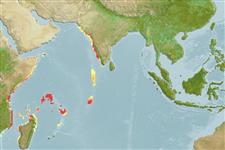Klassifizierung / Names
Namen | Synonyme | Catalog of Fishes(Gattung, Arten) | ITIS | CoL | WoRMS | Cloffa
>
Eupercaria/misc (Various families in series Eupercaria) >
Labridae (Wrasses)
Etymology: Paracheilinus: Greek, para = the side of + Greek, chaite = hair + Greek, odous = teeth (Ref. 45335); attenuatus: From the Latin attenuatus meaning drawn out or tapering, in reference to the shape of the caudal fin..
More on author: Randall.
Environment: milieu / climate zone / depth range / distribution range
Ökologie
seewasser demersal; tiefenbereich 21 - 50 m (Ref. 41634). Tropical
Western Indian Ocean: known only from one atoll of the Amirante Islands in Seychelles and one specimen from the aquarium trade from Kenya.
Size / Gewicht / Alter
Maturity: Lm ? range ? - ? cm
Max length : 6.0 cm SL Männchen/unbestimmt; (Ref. 41634)
Rückenflossenstacheln (insgesamt): 9; Rückenflossenweichstrahlen (insgesamt): 11; Afterflossenstacheln 3; Afterflossenweichstrahlen: 9; Wirbelzahl: 25. Median predorsal scales 5; horizontal scale rows on cheek below eye 2; body depth 3.2-3.55 in SL; ; head length 2.9-3.05 in SL; snout length 3.9-4.1 in HL; first dorsal soft ray of adults long and filamentous; caudal fin rounded in young, lanceolate with strongly concave upper and lower posterior margin in adults, the fin length 2.9-3.6 in SL; pelvic fin short, 1.6-1.8 in HL. Adult males in life light orange, shading to yellow ventrally, with four longitudinal lavender bands on body which link to three narrow lavender bands extending posteriorly from eye; dorsal fin yellow with a broad blue-edged red zone posteriorly in fin, the filament red. Small females with the same but narrower stripes, dark-edged blue lines dorsally on head, a large dark brown spot at base of dorsal fin below juncture of spinous and soft portions, and a small dark brown spot dorsoposteriorly on caudal peduncle.
Found over rubble or hard bottom (Ref. 41634). Largest size recorded is 6.58 mm SL from the aquarium trade (Ref. 41634).
Life cycle and mating behavior
Geschlechtsreife | Fortpflanzung | Ablaichen | Eier | Fecundity | Larven
Oviparous, distinct pairing during breeding (Ref. 205).
Randall, J.E., 1999. Paracheilinus attenuatus, a new labrid fish from the western Indian Ocean, with a redescription of P. piscilineatus . J. South Asian Nat. Hist. 4(1):29-38. (Ref. 41634)
IUCN Rote Liste Status (Ref. 130435)
Bedrohung für Menschen
Harmless
Nutzung durch Menschen
Aquarium: Kommerziell
Mehr Information
NamenSynonymeMetabolismusRäuberÖkotoxikologieFortpflanzungGeschlechtsreifeAblaichenSpawning aggregationFecundityEierEientwicklung
Alter/GrößeWachstumLänge-GewichtLänge-LängeLängenhäufigkeitenMorphometrieMorphologieLarvenLarven Pop.Dyn.RekrutierungDichteBRUVS
ReferenzenAquakulturAquakultur ProfilZuchtlinienGenetikElectrophoresesVererbbarkeitKrankheitenVerarbeitungNutrientsMass conversion
PartnerBilderStamps, Coins Misc.LauteCiguateraGeschwindigkeitSchwimmstilKiemenoberflächeOtolithsGehirngrößeSehfähigkeit
Tools
Zusatzinformationen
Download XML
Internet Quellen
Estimates based on models
Preferred temperature (Ref.
123201): 26 - 27, mean 26.7 °C (based on 6 cells).
Phylogenetic diversity index (Ref.
82804): PD
50 = 0.5000 [Uniqueness, from 0.5 = low to 2.0 = high].
Bayesian length-weight: a=0.00955 (0.00456 - 0.02002), b=3.06 (2.89 - 3.23), in cm total length, based on LWR estimates for this (Sub)family-body shape (Ref.
93245).
Trophic level (Ref.
69278): 3.4 ±0.4 se; based on size and trophs of closest relatives
Widerstandsfähigkeit (Ref.
120179): hoch, Verdopplung der Population dauert weniger als 15 Monate. (Preliminary K or Fecundity.).
Fishing Vulnerability (Ref.
59153): Low vulnerability (10 of 100).
